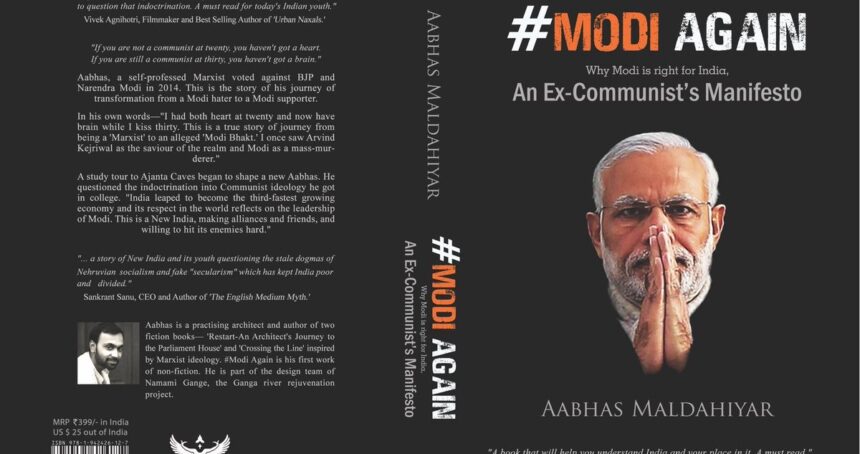The work carried out and the policies implemented during the last five years have once again raised India's standing in the world.
Before and After Prajñā: Journey of an ex-comrade

The forefathers worshipped the spontaneous nature of knowledge. A man surrounded by things cannot make sense of them by what is being taught at school but a critical event suddenly changes everything. He sees a pattern invisible to the naked eye. The architect Aabhas Maldahiyar had his Prajñā at the Ajanta caves, where Buddhist monks used refraction to light dark caves with sunlight. Water in stone depressions refracted and spread the incoming beams of sunlight inside the horseshoe-shaped cave.
The organic colours would be tarnished with soot had they used flames inside the caves. The colours and the wisdom stood the testimony of time, not the attention span of the ruling elite. Fate forbade them from being embedded in the history books of children. Despite having a father who doubled as a professor of History, Aabhas had his mind infused with The Enlightenment and the French Revolution and never the rich history of his nation. The history books did their job for he grew up confused about his identity and belonging.
The India around him was in his eye an extension of the same identity, messy, chaotic but ready to be organized. When order is what one is looking for, can Leninism be far behind?
At his architectural school, he experienced the ends of the spectrum. Free, unhindered forms and designs in the first semester and their limitations, or stupidity in the next. Order over chaos. A planned Chandigarh stood out among Indian cities of mohallas and clutter. Stalinist architecture with their stress on symmetry and order occupied the young mind.
He was politically aware if not active. Holding unto administrative posts even in his college union, he was inspired by the ‘India Against Corruption’ movement.
Yet, just like those Buddhist monks had visualized the journey of a man trying to overcome his ‘dukkha’ through understanding its cause, identifying what is actually him, the ‘anatma’ leading to bliss, Maldahiyar traverses within his finite universe in search of that what India needs.
The book talks about his journey through the market where his discontent lay with the goods he surveyed. He lays bare open his problems with his once “Hero” Kejriwal, The Left, Babri Masjid Historians, The Congress and The Media.
These pages might seem like something we all have lived. The twists and turns of Shri Arvind Kejriwal have often elicited similar reactions across all drawing rooms. He recounts how it affected his personal relationship with a friend. They started their journey together but differed on the fate of the movement.
The perennial question as to why the leftist parties never left the comfort of the regions they were embedded in and how it did not stand the test of time. The strangle on power has only made the skeletons tumbling out of closet look uglier, the latest of which is the Sabarimala temple. The Leftist Historians and their “expert” opinion on the Ayodhya movement had been carefully hidden from the public gaze. He critically investigates their claims and then shows their own testimony in court which can only be called a farce.
Instead of a thousand complaints with the grand old party, he picks the issue of Dalits. It does not need the escape velocity of Jupiter to show how Nehru ignored Ambedkar in the Cabinet, keeping him only to placate Gandhi and Babu Jagjivan Ram, the persons who recommended him. He was awarded a Bharat Ratna only in 1991, in the face of the Mandal issue and popularity of the Janata era politicians. If this is what happened to the Dalit icon, one can only imagine what Dalits themselves went through. The ever-present hyenas aka the journalists of the “What about 2002?” fame also get a mention as their agenda is laid bare.
As the book progresses, it feels like the author is completing the circumambulation of a Stupa. He assesses the critical steps of Narendra Modi and his government, his policies that started his slow gravitation back to the same place where he began. What he once hated and revulsed, was now understood and admired.
The foreign policies of the government, its tough posturing on terrorism, revamping of the economic policy, cleaning up the Ganga and India’s through his Swachh Bharat campaign, Maldahiyar walks us through the small leaps he took along with his Nation in the journey of self-realization; that reformation is possible and we are on the track.
There is a chapter on the Digitization drive of the Government and how it will help poor people who might themselves not have a computer. He provocatively titles one of his last chapters “The House of Commons” where he shows how every section of the society has benefitted in the past five years.
These last chapters again bring up what we felt but perhaps never said. The shrill and noisy environment of lynching, “khatre me haen” has eclipsed what we have achieved in the last five years.
People who have keenly followed Prime Minister Modi might know this already but it is also true that society is not a handful of individuals. It must be reinforced on the collective, the ground that has been covered in spite of the distraction. This should ring a bell to those who saw the achievements of the first NDA government of Atal Bihari Vajpayee fall by the wayside. Maldahiyar’s book “#MODI AGAIN (Why Modi is right for India) An Ex-Communist’s Manifesto” is thus a must read this election season.

Leave a Reply